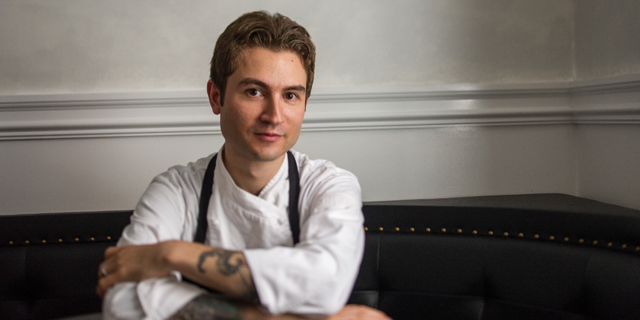For the venerable Alex Stupak, chef and owner of Empellón Taqueria and Empellón Cocina, 2013 was a big year. Celebrated by Food and Wine magazine as a “Best New Chef” and nominated by the James Beard Foundation for Best Chef, NYC, Stupak also unveiled the successful Push Project at his Empellón Cocina, inviting guest chefs such as Enrique Olvera, Grant Achatz, and Chris Consentino into his kitchen for culinary collaboration.
We get the draw; Stupak is someone we’re equally enthusiastic about. The reserved former pastry chef is slowly changing the face of Mexican cuisine in New York City, and garnering a following of both national and international fans as he achieves each new success. With rumors of a new project on the horizon, we were thrilled to catch up with him as he prepares to head south to Miami (first time!) for Food Network’s South Beach Food & Wine Festival. Here’s the first part of our interview with Stupak himself.
What drove you to become a chef?
When I was around 9 years old, I had a cookbook for kids, and I made the recipe for Russian dressing: ketchup, mayo and relish. I dressed a salad with it, and handed it to my mom for lunch. This made her happy, and that was a really cool moment for me. I’m pretty shy, and I learned early on that cooking was a great way to express yourself without being an extrovert.
You started as a pastry chef in incredible kitchens like Clio, wd-50 and Alinea. What drove you to pursue pastry as a vocation?
I actually started out as a chef, but two things pushed me toward pastry. First, I fell in love with the work of Albert Adria. My boss at Clio, Ken Oringer, gave me Adria’s first cookbook. Through that, I realized that the work of El Bulli was driven by the pastry kitchen, and that inspired me. Second, being a pastry chef is about independence. If you’re a pastry chef at a small restaurant, you’re somewhat left alone in your own little corner of the kitchen. Plus, it’s the quickest way to having your name on a menu — pastry affords a feeling of ownership without the liability of actually owning anything.
Next up, Chef Stupak’s unexpected culinary curveball…
[pagebreak]
When you changed culinary gears, it was to cook what you loved to eat: tacos. So…what’s your favorite taco combination/filling?
Braised tongue, chile de arbol, caramelized onions. I also love a fish tempura taco with lots of mayo and cabbage.
How did you immerse yourself/palate in Mexican food to prepare for the openings of Empellon, and later, Empellon Cocina?
No different than pastry. I read and continue to read anything I can get my hands on pertaining to Mexican food. I go to Mexico at least 4 times a year. I eat in Mexican restaurants around the U.S.
Who are your Mexican culinary influences?
Enrique Olvera, Alejandro Ruiz, Jorge Vallejo. All the guys pushing the envelope in Mexico.
Tell us about what you foods you seek out when you visit Mexico.
The rare and the new. Last time I was in the Yucatan, I discovered jicadillo, which is essentially cochinita pibil made with the organs of the pig. Most recently, I was in Oaxaca, learning about masa and mezcal production, and I had these tamales called tichinidas, which were made with wild mussels and clams in the shell. When the mussels and clams are left in the shell, mixed into the masa, and then cooked in the banana leaf, it insures that the juice inside the clams and mussels enriches the flavor of the tamale. When you opened the leaf to eat the tamale, you just pick out the shells. I had never seen that before.
With the opening of your restaurants, you have elevated the notion of what Mexican cuisine can be. How do you view the Mexican food landscape in NYC?
In my opinion, 2014-15 will be critical years. Different than Chicago and LA, New York doesn’t have a deeply rooted Mexican infrastructure in the city; Mexican immigrants are spread out throughout the boroughs. In places like LA and Chicago, where the populations are living in close proximity, masa factories and tortillerias abound. Here, not as much. Over the next 10 years, I see our Mexican chefs focused on curating the products we need to raise the bar on Mexican food.
Similar to what Bayless has done in Chicago?
Yes, exactly. I have tremendous respect for Rick Bayless. The talent is here. The information is here. A big piece that’s missing is getting the ingredients, getting seeds for foods like boniato (a Latin tuber) for example, and getting the farmers here to grow those seeds. Chefs will also become farmers themselves. 15 years ago, Italian Arborio rice (used to make risotto) was difficult to find and source here. Now, you can easily find Arborio rice and use it in various ways. I see the same evolution happening in Mexican food.
How we define Mexican food here also needs to change. To most, Mexican food translates to street stalls and tacos stand, associated with being uber-cheap. We need to alter that perception. When you say Italian food, you think of a variety of different kinds of Italian foods that can be had in New York City: a quick slice of pizza, a bowl of pasta, all the way up to high-end, four-star dining experiences. We need people to think of Mexican food in the same way.
Stay tuned tomorrow for talk about Stupak’s next PUSH Project and The South Beach Wine and Food Fest…


![Making Mealtime Matter with La Familia: Easy Sofrito [Video]](https://thelatinkitchen.com/wp-content/uploads/2015/10/sofrito-shutterstock__0-500x383.jpg)
![Easy Latin Smoothies: Goji Berry Smoothie [Video]](https://thelatinkitchen.com/wp-content/uploads/2015/12/goji_berry-shutterstock_-500x383.jpg)
















![Fun and Fast Recipes: Fiesta Cabbage Salad [Video]](https://thelatinkitchen.com/wp-content/uploads/2015/11/fiesta_cabbage_slaw-shutterstock_-500x383.jpg)









